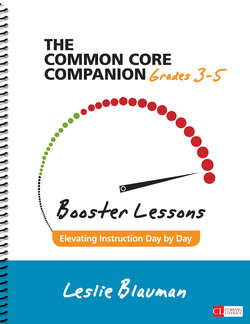Читать книгу The Common Core Companion: Booster Lessons, Grades 3-5 - Leslie Blauman - Страница 69
На сайте Литреса книга снята с продажи.
Fifth-Grade Adaptation
ОглавлениеBy fifth grade, students should understand point of view and author’s intent. The difference is that they need to describe how that affects the description of the events in the text. Novels written from different perspectives are a wonderful way to teach this standard; however, it takes time to work through an entire novel. For a shorter lesson, I go back to the sports column, using one sporting event but pulling articles from the hometowns of each team. Columnists have a strong point of view and they will describe the events of the game from that vantage. In addition, the word choice is generally terrific and sports columnists write with strong verbs. Finally, these articles can be quickly found on the day you need them (Google!) and either displayed on an interactive whiteboard or downloaded and printed.
The purpose for this lesson is to identify the narrator’s or speaker’s point of view and describe how that affects how the events in the text are depicted.
Pass out the first article (I generally start with the home town) and either read through it together (shared experience) or have students read it independently. In this first reading, they should be determining the POV and how they figure it out.
When finished with the first reading, turn and talk or share thinking with the group. In the second reading, students should highlight where in the text the author describes specific events. Then they should code (leave tracks of their thinking) in the margins about how the narrator views these events—positively? Negatively?
Discuss their thinking and then pass out the second article from the rival team’s hometown. Again, have students read through the first time just to determine the narrator’s point of view. Turn and talk and discuss thinking. As with the first article, they need to highlight where in the text the narrator describes specific events. However, students use the same colored highlighter as they used on Paper 1 if the narrator describes the event in a similar manner to the first author. They use a different color highlighter if the event description is different.
When students finish highlighting both articles, they meet in small groups (this could be on the following day if there is a time issue) to discuss the focus question—How does the narrator’s point of view affect how the events in the text are depicted? After small group discussion, bring the whole group together to debrief.
If you have time to read a shared novel, or even a read-aloud book, model and think aloud, how you would answer these questions:
Who is telling the story?
What is happening in the story? How does the narrator’s or speaker’s point of view affect the description of events in the text?
What effect does this text have on me? Why?
Ultimately, the goal is for students to internalize the questions and ask and answer them as they read. Book clubs, literature circles, and written responses allow students to demonstrate understanding.
